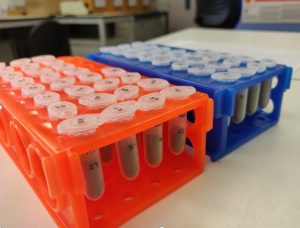
Samples crushed into a fine powder.
This summer I went on a research experience placement with The Open University’s School of Environment, Earth and Ecosystem Sciences (EEES). This was a seven-week project, funded by NERC (Natural Environment Research Council).
The project was to assist in a calibration of results obtained from deep-sea core sediment samples from two different sites around the Bay of Bengal.
The calibration is part of a wider project that my colleague, Emmeline Gray is working on for her PhD. This is looking at how the Indian Summer Monsoon (ISM) behaved during a past warm period (similar to predicted future conditions) by observing how certain parameters in the sea floor sediments at these sites vary over time. This could give an insight as to how climate change might affect our oceans over time.
The aim was to combine two types of data, one of high resolution and non-quantitative and one of low resolution that is quantitative, containing information on the abundance of a range of elements within the sediment (e.g. Calcium, Titanium, Bromine) in order to find concentration values of these elements.
The first data was previously obtained X-ray fluorescence data (XRF) which displays abundance of these elements in counts (arbitrary units) and so the aim was to eventually display concentration values as well as counts, and apply this to all of the XRF data. This will allow us to observe exactly how much of each important element is in the sediment (in parts per million) by collecting ICPMS (Inductively coupled plasma mass spectrometer) data.
This then introduced the main bulk of the practical work I was involved with. In order for samples to be analysed in the ICPMS, we needed to dissolve the samples in solution.

An image of the ICPMS instrument.
The first few weeks of my placement were spent preparing samples from one of the sites. This involved picking out samples using graphs of XRF counts vs the depth of the sample to make sure the selected samples spanned the range of counts.
As shown below with Calcium, I had to be aware of the peaks in the graph. However, I ignored one large trough, as the extreme in XRF data could be due to ash layer or cracks in the section. This means cracks can present themselves in the scans as large gaps/troughs within the depth curves, or gaps could arise from ash layers in the sediment, such as the gap at around 36m on the graph below.

Graph of XRF Counts of Calcium within the sediment.
Once I’d finished picking the samples I wanted to use, they needed to be weighed and crushed to a fine powder in order to be dissolved.
After crushing the samples we went into the clean lab to digest the samples in a series of additions of various concentrated acids (as the samples at this site are very carbonate rich). However, even after several steps adding various acids including hydrofluoric acid (HF) and aqua regia (a mixture of hydrochloric and nitric acid) we found that the digestion was not complete.
This meant that the procedure had to be completely rethought, as we did not expect this to happen in a carbonate rich sample. We still are unsure what the solid is, although as it has not yet dissolved in aqueous acid we believe it could be organic material.
This evaluation of the method along with writing my report was done in the final few weeks of my project. I also gave a small talk to the Palaeoenvironmental Change Group of PhD students and academics in the School outlining the work I was doing in the project.
Special thanks go to my mentor/project provider Dr Pallavi Anand and Dr Katrina Nilsson-Kerr at The Open University for giving me the opportunity to be a part of this project and to NERC for providing research projects aimed at students like myself across STEM fields outside of Earth Science to further encourage research. I would also like to specially thank Emmeline Gray for her help working with me on this research as part of her PhD project.
Overall, even though we hadn’t yet got results from the ICPMS in the 7 weeks I was working (due to the unexpected problems we faced when dissolving the samples), this project has given me a huge insight into Earth Science and the general approach to tackling problems within the research world. Working in this environment has helped me see that there can always be some unexpected/unexplainable results even at this level of science and has prepared me for dealing with this in the future.
This knowledge is valuable to me as I am currently heading into my third year of my Chemistry degree where I will be conducting a research project of my own, so working here has overall been a worthwhile, valuable and enjoyable experience.
